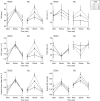Physiological adaptations to chronic stress in healthy humans - why might the sexes have evolved different energy utilisation strategies?
- PMID: 27027401
- PMCID: PMC4967762
- DOI: 10.1113/JP272021
Physiological adaptations to chronic stress in healthy humans - why might the sexes have evolved different energy utilisation strategies?
Abstract
Key points: The human stress response activates the autonomic nervous system and endocrine systems to increase performance during environmental challenges. This response is usually beneficial, improving the chance of overcoming environmental challenges, but costs resources such as energy. Humans and other animals are known to adapt their responses to acute stress when they are stimulated chronically, presumably to optimise resource utilisation. Characterisation of these adaptations has been limited. Using advanced imaging techniques, we show that cardiovascular and endocrine physiology, reflective of energy utilisation during acute stress, and energy storage (fat) differ between the sexes when they are exposed to chronic stress. We examine possible evolutionary explanations for these differences, related to energy use, and point out how these physiological differences could underpin known disparities between the sexes in their risk of important cardiometabolic disorders such as obesity and cardiovascular disease.
Abstract: Obesity and associated diseases, such as cardiovascular disease, are the dominant human health problems in the modern era. Humans develop these conditions partly because they consume excess energy and exercise too little. Stress might be one of the factors contributing to these disease-promoting behaviours. We postulate that sex-specific primordial energy optimisation strategies exist, which developed to help cope with chronic stress but have become maladaptive in modern societies, worsening health. To demonstrate the existence of these energy optimisation strategies, we recruited 88 healthy adults with varying adiposity and chronic stress exposure. Cardiovascular physiology at rest and during acute stress (Montreal Imaging Stress Task), and body fat distribution were measured using advanced magnetic resonance imaging methods, together with endocrine function, cardiovascular energy use and cognitive performance. Potential confounders such as lifestyle, social class and employment were accounted for. We found that women exposed to chronic stress had lower adiposity, greater acute stress cardiovascular responses and better cognitive performance. Conversely, chronic stress-exposed men had greater adiposity and lower cardiovascular responses to acute stress. These results provide initial support for our hypothesis that differing sex-specific energy conservation strategies exist. We propose that these strategies have initially evolved to benefit humans but are now maladaptive and increase the risk of disorders such as obesity, especially in men exposed to chronic stress.
© 2016 The Authors. The Journal of Physiology © 2016 The Physiological Society.
Figures


Similar articles
-
Habitual alcohol consumption is associated with lower cardiovascular stress responses--a novel explanation for the known cardiovascular benefits of alcohol?Stress. 2013 Jul;16(4):369-76. doi: 10.3109/10253890.2013.777833. Epub 2013 Apr 8. Stress. 2013. PMID: 23425242
-
Adiposity is associated with blunted cardiovascular, neuroendocrine and cognitive responses to acute mental stress.PLoS One. 2012;7(6):e39143. doi: 10.1371/journal.pone.0039143. Epub 2012 Jun 20. PLoS One. 2012. PMID: 22745709 Free PMC article.
-
Cardiovascular and cortisol reactions to acute psychological stress and adiposity: cross-sectional and prospective associations in the Dutch Famine Birth Cohort Study.Psychosom Med. 2012 Sep;74(7):699-710. doi: 10.1097/PSY.0b013e31825e3b91. Epub 2012 Jul 20. Psychosom Med. 2012. PMID: 22822233
-
The effects of sex and hormonal status on the physiological response to acute psychosocial stress.Psychoneuroendocrinology. 2006 Feb;31(2):151-78. doi: 10.1016/j.psyneuen.2005.07.002. Epub 2005 Sep 1. Psychoneuroendocrinology. 2006. PMID: 16139959 Review.
-
The Minderoo-Monaco Commission on Plastics and Human Health.Ann Glob Health. 2023 Mar 21;89(1):23. doi: 10.5334/aogh.4056. eCollection 2023. Ann Glob Health. 2023. PMID: 36969097 Free PMC article. Review.
Cited by
-
Impact of chronic unpredicted mild stress-induced depression on repaglinide fate via glucocorticoid signaling pathway.Oncotarget. 2017 Jul 4;8(27):44351-44365. doi: 10.18632/oncotarget.17874. Oncotarget. 2017. PMID: 28574832 Free PMC article.
-
A Longitudinal Epigenetic Aging and Leukocyte Analysis of Simulated Space Travel: The Mars-500 Mission.Cell Rep. 2020 Dec 8;33(10):108406. doi: 10.1016/j.celrep.2020.108406. Epub 2020 Nov 25. Cell Rep. 2020. PMID: 33242403 Free PMC article.
-
Sex-related pathophysiological mechanisms may be present before symptoms of HFpEF develop.ESC Heart Fail. 2025 Jun;12(3):2387-2390. doi: 10.1002/ehf2.15228. Epub 2025 Feb 28. ESC Heart Fail. 2025. PMID: 40022454 Free PMC article. Clinical Trial.
-
Neuroendocrine contribution to sex-related variations in adverse air pollution health effects.J Toxicol Environ Health B Crit Rev. 2024 Nov 16;27(8):287-314. doi: 10.1080/10937404.2024.2383637. Epub 2024 Jul 29. J Toxicol Environ Health B Crit Rev. 2024. PMID: 39075643 Review.
-
Relationship Between Chronic Stress and Heart Rate Over Time Modulated by Gender in a Cohort of Office Workers: Cross-Sectional Study Using Wearable Technologies.J Med Internet Res. 2020 Sep 9;22(9):e18253. doi: 10.2196/18253. J Med Internet Res. 2020. PMID: 32902392 Free PMC article.
References
-
- Baecke JA, Burema J & Frijters JE (1982). A short questionnaire for the measurement of habitual physical activity in epidemiological studies. Am J Clin Nutr 36, 936–942. - PubMed
-
- Bellingrath S & Kudielka BM (2008). Effort‐reward‐imbalance and overcommitment are associated with hypothalamus‐pituitary‐adrenal (HPA) axis responses to acute psychosocial stress in healthy working schoolteachers. Psychoneuroendocrinology 33, 1335–1343. - PubMed
-
- Borders TF, Rohrer JE & Cardarelli KM (2006). Gender‐specific disparities in obesity. J Community Health 31, 57–68. - PubMed
-
- Brunner EJ, Chandola T & Marmot MG (2007). Prospective effect of job strain on general and central obesity in the Whitehall II Study. Am J Epidemiol 165, 828–837. - PubMed
Publication types
MeSH terms
Substances
Grants and funding
LinkOut - more resources
Full Text Sources
Other Literature Sources
Medical

